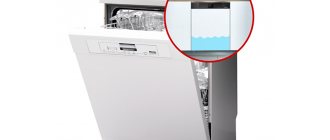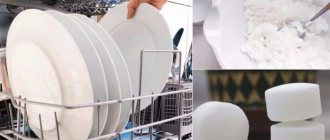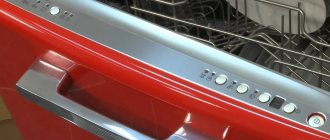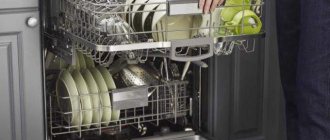Having a dishwasher not only relieves stress physically, but also saves the housewife time. Household appliances are now not uncommon; manufacturers offer expensive and economy-class units. But a high price offer does not guarantee that a specific odor will not arise during operation. There may be several reasons for such an unpleasant phenomenon. To get rid of the smell in the dishwasher, you need to determine the nature of its occurrence. Residues of food, stagnation of water, technical problems or incorrect installation not only cause a specific “aroma”, but also shorten the life of the device and deteriorate the quality of washed dishes.
Why does the dishwasher smell?
The dishwasher requires special attention and care. A prerequisite is compliance with the operating instructions. There can be several reasons why your dishwasher smells bad: stuck food waste, mold, unsuitable detergents, or stagnant water.
Leftover food
Food blockages are one of the common problems. Particles can settle in the filter, at the bottom of the dishwasher, or remain on the walls or surface of the door. You can observe the remains of unwashed food on the bottom bar of the machine, near the place where the door is attached. Also, if installed incorrectly, products settle on the drain pipe or the hose itself. If food waste remains in the unit, an unpleasant odor will certainly appear after a certain time.
Stagnation of water
Water may accumulate in a small amount in the pan of the machine. This is enough for the waste liquid to stagnate and a musty smell to appear. There may be several reasons for this phenomenon, but most often the drain hose was positioned incorrectly during installation. It is necessary to remove the liquid and run the dishwasher on the “Self-Cleaning” function. You can remove the water manually and wash the tray.
Failure to follow operating instructions
Not every kitchen utensil can be cleaned in the dishwasher. The instructions describe materials that cannot withstand high temperatures; plastic is prohibited. When heated, it begins to melt, causing a burning smell in the dishwasher. It is not recommended to place wooden cutting boards into the unit if they are glued together from several layers. When heated, the presence of glue will be felt, which will be problematic to get rid of.
Mold
Offensive odors in your dishwasher can be caused by mold. The fungus develops in hard-to-reach places: in water supply or drain hoses, near the heater, in the filter, in the door cuff. Visually determining where exactly the mold concentration is located is quite difficult.
Fungus can get into the car if the room is damp or the ventilation is poor
In this case, it is easier to prevent the appearance of odor than to fight it.
Advice! The dishwasher should be ventilated more often and should not be left with damp dishes in it with the door hermetically closed.
Unsuitable detergents
Special salt must be added to the kitchen unit to soften the water. The product also affects the quality of operation of household appliances and eliminates unpleasant odors. A liquid rinse (with or without fragrance) is also recommended.
If you use cheap detergent or do not follow the dosage, an unpleasant chemical smell may remain in the dishwasher, and a greasy film may remain on the walls.
Why does a new dishwasher smell while it's running?
When a new dishwasher is running, it may smell foul for several reasons:
- Household appliances are made of low-quality material, which when heated begins to emit an unpleasant odor. As a rule, the problem resolves itself after a few cycles.
- A more serious situation is accompanied by burning. The problem is that the contacts on the instrument panel of the car begin to melt. The cause may be voltage fluctuations in the network or manufacturer errors. In this case, you need to turn off the dishwasher and use the service.
- Burning wiring or a heating element is difficult to miss. The machine may still work for some time, the breakdown will appear later, but the smell will be present.
Important! At the first sign of burning, the equipment must be turned off and not used until the cause is identified and eliminated.
Why does my dishwasher smell like sewer?
A musty, sewer-like odor indicates a serious problem. It cannot be eliminated by cleaning the parts. If installation is carried out incorrectly, the unit will smell like sewage. The drain hose should be at an angle of approximately 40–100 cm above the floor, and not immediately mounted into the pipe. A siphon is required.
Correct installation of the drain hose will help eliminate sewer odor in the dishwasher.
Causes of unpleasant odor
If the machine is working properly and is used according to the instructions, there will be no smell coming from it. It occurs for a number of reasons, including:
Mold growth . The favorite habitats of fungi are: drain filter, hoses, door seal, tubular electric heater. Their appearance is promoted by high humidity and insufficient ventilation.- Incorrect operation . Do not load plastic dishes into the machine. Failure to comply with this condition will result in a burning smell.
- Using low-quality detergents . There are special gels and capsules for the dishwasher that cannot harm the device or cause an unpleasant odor.
- Formation of blockage . Most often it is represented by food waste, which can accumulate in the mesh filter area, inside the drain hose, under the cuff.
- Water stagnation . It may accumulate under the cuff and at the bottom of the device. Its rotting will lead to the appearance of an unpleasant odor.
How to get rid of odor in your dishwasher
Before removing odor from your dishwasher, you need to determine its source. If there is no specific opinion on where it is coming from, you will have to check all the problem areas in the dishwasher.
Filter check
Each household appliance comes with instructions that clearly describe the sequence of a particular job. Basically, in all models the filter is located in easy accessibility - at the bottom. To remove odor from your dishwasher:
- The filter is unscrewed and removed. It consists of parts: a plastic part in the form of a rack of threaded cells and an internal mesh base.
- The devices are disassembled and food remains are removed.
- Wash under running water. You can use any dishwashing detergent.
The mesh part is cleaned with a brush. To avoid damage, no force is needed.
The filter is assembled and installed in place, tightened until a characteristic click is heard.
Drain hose
If the unpleasant odor from the dishwasher persists after washing, and the source is not visually observed, it is recommended to clean the drain hose. They do this as follows:
- If water is found in the pan, it is removed.
- The dishwasher is turned on to the “Drain” function. This will remove any remaining liquid.
- The hose is unscrewed from the unit and disconnected from the drain point.
- Rinse well with hot water. To remove residual fat, you can use any alkali-based product.
- If the problem cannot be solved without additional equipment, use special brushes or wire wrapped in fabric.
After the procedure, the hose is returned to its place.
Checking the door gasket
Dishwashers may be equipped with rubber bands on the door. Food residue stuck in the seal may smell. To eliminate the smell from the dishwasher, you must first remove the grates, coat them with detergent and leave for a few minutes. Further actions:
- Using hot water and some cleaning agent, wash all the interior walls and door.
- Lifting the rubber gasket, wash with a sponge under it, then on top.
- If there is no rubber band, you can clean the joint with a toothbrush.
Replace the grilles and start the “Rinse” mode.
Pipes
It is recommended to check and clean the pipes from contamination at least once every 1.5-2 months. They do this as follows:
- It is necessary to stop the water supply to the dishwasher and close the tap.
- Disconnect the water supply hose from the tap and unit.
- Unscrew the filter and clean it well.
- Disconnect the pipes. Rinse well and rinse them with hot water and detergent.
- Under the pressure of water, also clean the hose itself.
Wipe the parts with a clean cloth, reinstall and screw the hose into the dishwasher, and resume the water supply.
Spray nozzles
Spray elements are located at the top and bottom of the dishwasher, attached to the bottom and top grid. They look like an oblong plank equipped with holes on which food debris or lime deposits accumulate. Bacteria begin to multiply and the machine smells unpleasant. To prevent this:
- The nozzles are removed and the surface is cleaned.
- Soak in water at a temperature of +50 0C.
- Leave for 20 minutes.
- Rinse under the tap. If necessary, remove food residues with a brush.
Basic methods for solving the problem
Regardless of the causes of the problem, it should be solved as soon as possible, since bacteria that arise when the device is contaminated get onto the dishes and can harm human health. In addition, if not properly maintained, dirt in the dishwasher can lead to its breakdown and failure.
Inspection, cleaning and prevention
First of all, if a problem is detected, it is necessary to clean the sink. It is necessary to thoroughly clean the power filter, drain hose, pipes and nozzles from blockages and dirt.
Strainer
First of all, wash the strainer. It is located at the bottom of the machine. This part should be cleaned regularly - once a week, as fats actively accumulate in it. Remove the lower basket and disassemble it. Remove the filter, wash it with plain soap and water, and replace it.
Drain hose
Disassemble the dishwasher and remove all baskets. Turn it over on its back and unscrew the back cover screws. Unfasten the wiring. Unscrew the pump screw. Rotate the pump and disconnect it. Check for blockages and rinse thoroughly, then reassemble the device.
Chemical odor removers
To clean your dishwasher from odors, there is a wide range of household chemicals on sale: formulations without chlorine, with the addition of substances that gently remove limescale and grease residues, and disinfect the surface and parts of the machine. After treatment with such substances, the dishwasher does not smell.
The most popular inexpensive but effective means:
- "Calgonit Fusion Power" removes scale and fat deposits. This is a multifunctional tool. In addition to cleaning, it disinfects the surface and parts of the unit.
- Produced in Germany. The instructions indicate that with regular use of the product, the machine's performance will last longer. “UniPlus” removes grease deposits, cleans the surface of lime, and eliminates odors.
- Electrolux. The main advantage of the product is the elimination of fungus and bacteria.
All chemicals contain phosphates and alkali. Therefore, after cleaning household appliances, it is necessary to turn on the rinsing or self-cleaning mode.
Traditional methods for cleaning dishwashers from unpleasant odors
You can remove odors from your dishwasher using traditional methods. I use them when I don’t have special household chemicals on hand or they cause an allergic reaction. To save money, homemade recipes are also suitable.
Table vinegar
Vinegar is taken at 6 or 9%. Stronger concentrations may damage plastic parts. Cleaning method:
- Pour 100 ml into a mug or glass.
- They put it on the grill. It’s better to go to the top so that the water pressure overturns the glass.
- You can run the appliance without dishes, when the water fills, pause, open the door and pour in vinegar.
After finishing work, there will be no residual grease, food odors or acid left in the dishwasher.
Baking soda
To prevent your dishwasher from smelling, you can use baking soda. Powder (about ½ pack) is poured onto the bottom and all surfaces are carefully cleaned with a sponge. Then the empty dishwasher is started in normal mode so that the water warms up to a temperature of at least +60 0C. When draining, the liquid with soda will clean the filter and hose parts.
Borax
An effective odor remover. You can buy it at the pharmacy. How to use:
- pour a little product onto the bottom;
- use a damp sponge to treat all accessible parts;
- add another 20 g of borax.
Start the machine in normal mode (without dishes).
Sodium tetraborate or borax is a white powder with a crystalline structure that resembles salt
A mixture of hydrogen peroxide and baking soda
To prepare the product, take a pack of soda and 10 ml of peroxide. Mix the components in a ceramic or plastic container, after the reaction put it in the refrigerator, you will get a dense substance in the form of a lump. Place it on the rack and turn on the dishwasher at maximum temperature. If desired, you can add a few drops of any essential oil as a flavoring.
Recommendations for care and use
In order not to encounter the problem of unpleasant odor in the dishwasher, you must follow a number of simple operating rules:
- Before loading, remove all food debris from the dishes.
- After completion of work, kitchen utensils are removed immediately. If this is not possible, open the door to allow the surface to dry.
- Use products recommended for dishwashers, good quality, that break down fats.
- You should not leave the unit loaded with dirty dishes for a long time, especially with the door closed.
- Do not allow water to stagnate in the pan.
- The self-cleaning function should be run periodically.
Important! After each procedure, clean the drain filter.
Prevention measures
In order not to waste time, effort and money on a difficult and often hopeless fight against odors, it is better to prevent their occurrence:
- Thoroughly clean the dishes from leftover food before placing them in baskets;
- periodically check the machine for the accumulation of food residues and bacteria, the formation of mold and scale, and the appearance of odors;
- run a dishwasher at high temperature at least once a month to remove deposits that still form inside the machine;
- do not keep dirty dishes in the chamber for a long time;
- do not leave washed dishes in the machine chamber for a long time;
- after each wash, leave the PMM open to dry, then wipe the door seal and hopper dry;
- periodically manually clean the dispenser trays from powder residues;
- regularly clean the drain and inlet filters, periodically rinse the drain hose;
- use high-quality detergents;
- Periodically clean the machine from scale using special means.











